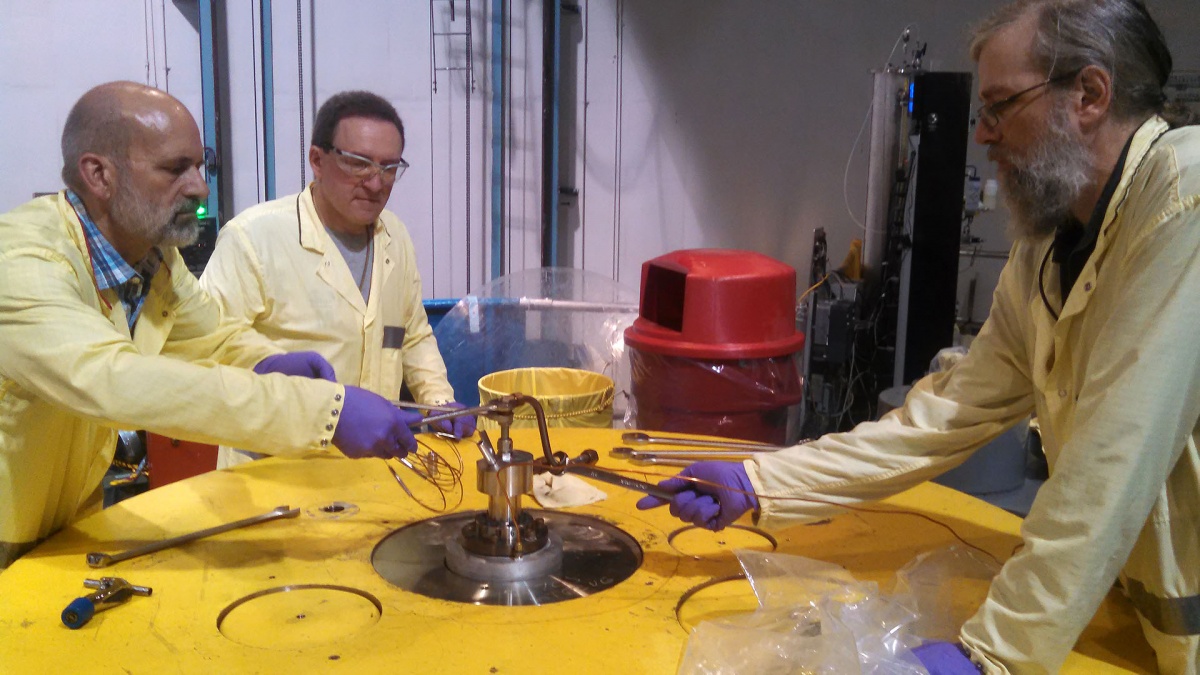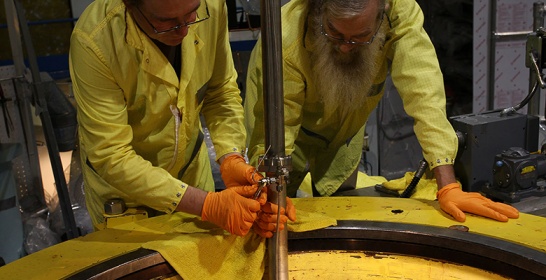The MIT research reactor: An early NSUF partner facility
When the Massachusetts Institute of Technology Research Reactor (MITR) celebrates its 60th birthday in 2018, it will also mark a decade of groundbreaking work with the Nuclear Science User Facilities (NSUF). The NSUF consortium, part of the Department of Energy’s Office of Nuclear Energy (DOE-NE), merges the resources of national nuclear laboratories, industry, and university-based nuclear research centers to advance the nation’s nuclear energy goals.
A founding partner of the NSUF, MITR has built a unique track record as a major U.S. nuclear materials testing center, according to Lin-Wen Hu, director of research and services and senior research scientist at the reactor lab. “We are the only university research reactor that can do this type of irradiation work,” she said, “and we specialize in first-of-a-kind experiments.” MITR’s pioneering projects with the NSUF include experiments in heat-dispersing fuels and accident-tolerant materials, and the development of new sensors for detecting conditions inside reactors.
A seed for the NSUF consortium was planted in 2007 by Hu and David Moncton, director of the MIT Nuclear Reactor Laboratory (NRL), who offered the DOE irradiation testing space to supplement limited reactor irradiation positions at national nuclear research facilities. Hu said that the DOE was eager to leverage existing facilities outside of the national labs to support users who might not otherwise gain access to irradiation facilities. The DOE’s Advanced Test Reactor (ATR) at the Idaho National Laboratory (INL), the first and only DOE-NE designated user facility, formed a partnership with MITR.
The ATR-NSUF/MITR collaboration served as the first phase in what has become the NSUF, today a consortium of 21 partner facilities. Within the consortium, only three offer experimental nuclear reactor conditions that can replicate the temperatures, pressures, and radiation environments found in U.S. power reactors: INL’s ATR, the High Flux Isotope Reactor at Oak Ridge National Laboratory; and MITR.
MIT’s facility, located on the university campus, is smaller than those of the national labs, with its reactor licensed for 6 MWt. Nevertheless, MITR holds its own as an irradiation facility. “We compress power generation in a small space so the radiation level can go as high as possible,” said David Carpenter, MITR group leader for reactor experiments. “A year of irradiation in our reactor is the same as in a full-size power reactor, which is one of our bigger selling points.”

Gordon Kohse, Yakov Ostrovsky, and Michael Ames at the reactor top making connections to the in-core water loop.
Experimental expertise
In the past decade, MITR has attracted a range of NSUF projects with researchers looking to take advantage of the facility’s features, including in-core positions for testing high-temperature samples and fissile materials, a pressurized water loop, high-intensity neutron beam, and hot cells for post- irradiation examination. Another important feature of MITR is its knowledgeable staff of nuclear scientists and engineers.
“We have a lot of experience coming up with good ways to run experiments, staying within budget and safety limitations, and moving things along quickly,” said Gordon Kohse, NRL deputy director for research and services and principal research engineer. “We can often find innovative ways to approach an irradiation while still gaining the approval of our safety committee and the Nuclear Regulatory Commission, which distinguishes us as a user facility.”
Tasked with testing challenging new nuclear technologies, MITR researchers design and install customized experimental setups for each NSUF project. “This means that we build a whole environment customized for a single experiment, one that may not get used again,” Kohse said.
“We are a laboratory for demonstrating proof of concept,” Hu noted. “We form the first link in the chain, because if an idea shows promise at MITR, it can be continued at a larger facility, such as ATR, with a greater investment of resources.”
MITR collaborates from start to finish, including collecting and analyzing data. “We’re not just checking off paperwork but are assisting people who might never have done irradiations before and who need help determining what can be done practically and safely, in a way that produces useful results,” Carpenter said.
A case in point: Starting in 2013, Carpenter began shepherding an NSUF project named ULTRA that sought to investigate the potential use of ultrasonic-powered sensors to monitor temperatures inside nuclear power reactors. The goal was to develop a device that could withstand extreme conditions over long periods of time in a range of positions inside a reactor while providing continuous readouts of temperatures.
The researchers, from INL and Pennsylvania State University, brought MITR several different sensor types, which had previously been tested under normal and high-temperature conditions. They needed MITR to see how the devices would fare under irradiation.
“We realized that some of the types they brought us would not hold up well under the combination of radiation and temperature conditions they wanted,” Carpenter explained, “so we helped them configure the best sensors for running the experiment.”
In the first round of ULTRA, Carpenter engineered a capsule containing seven different sensors, each capable of sending and receiving signals based on the reflection of an ultrasonic wave. Wires leading out of the capsule permitted the real-time collection of data during irradiation, captured by computers that Carpenter programmed specifically for the purpose. The magnitude and speed of the reflection were used to infer the temperature in the part of the reactor in which the capsule was suspended. The capsule also contained traditional temperature sensors to verify ultrasonic sensor data.
After 15 months, Carpenter and the NSUF investigators removed the capsule for examination in a hot cell. “Most of the sensors survived, which we didn’t expect,” he said. “But some of them retained their properties better than others, maintaining their signal strength and providing stronger data.” Based on these successful results, Carpenter is preparing for a follow-up round of ULTRA.
He will also be testing an entirely different kind of sensing device: a 40-meter-long fiber optic cable from the University of Pittsburgh. This cable, modified with deliberate damage points along its length, will be suspended in the reactor core, where researchers will shoot laser light into it.
“The theory is that as the fiber heats up in the core, it expands, and the different damage points along its length will bounce the laser light back at time intervals that correspond to different temperatures,” Carpenter explained. “This is a hugely exciting prospect, because you could get a real-time temperature map from 1,000 points across the entire reactor, compared to the limited number of readings we can get today.”
Current generation power reactors stand to benefit should ULTRA’s temperature sensing devices show promise, maintaining their integrity in the face of irradiation, temperature, and time. “We might be able to run a reactor more aggressively at a higher power, knowing for sure what temperatures we’re achieving in all parts of the reactor,” Carpenter said. “This could make reactor operations more efficient while meeting strict safety guidelines.”
Testing cooler fuel
Another important thrust of NSUF research performed at MITR involves fuel design and development, with the goal of creating better heat removal from the core. Even before the Fukushima Daiichi accident, scientists were looking to find ways to reduce the accumulation of heat in nuclear reactor cores. “The ceramic fuel in almost all commercial reactors now, uranium dioxide, tends to be thermally insulating, which means that the center of the fuel rods gets very hot,” Kohse said. “It would be very useful to have fuels that conduct heat better in case problems arise with pumps or coolant.”
With Kohse as the technical lead, MITR and its NSUF partners designed an experiment to determine whether different configurations of uranium-zirconium hydride fuel offered potentially better thermal conductivity, permitting heat from reactions in the fuel rods to disperse more effectively.
The experimental setup featured fuel pellets surrounded by a lead-bismuth mixture, encased in a titanium tube suspended in the reactor coolant. For the duration of the experiment, Kohse measured the temperature inside the middle of the fuel pellets and at the outside of the metal cladding surrounding the fuel. “By measuring the temperature difference we were able to infer the thermal conductivity of the fuel and see how much it changed as we ran the experiment,” he said. “We successfully studied how the ability of that fuel to conduct heat changed over time, as neutrons and other particles from the nuclear reactions changed the structure of the fuel.”
A problem with the fuel cladding brought the experiment to an end after six months, and the nuclear industry is not currently interested in zirconium-hydride fuels. Nevertheless, Kohse said, the project “was still valuable, because we learned how to conduct useful fuel experiments. It enabled us to look at the question of thermal conductivity for new reactor concepts, including those cooled by molten salt.”
Today, MITR stands poised to launch several multiyear NSUF projects, including the third ULTRA experiment, a test of radiation-hardened optical fiber sensors that were improved based on previous tests in MITR. Such projects, like their predecessors, will no doubt raise unexpected questions and bring some surprises. But these will prove welcome challenges for the MITR staff.
“We have some of the best experimenters in the community who have long track records in developing specialized experiments and enjoy finding solutions to unexpected problems,” Hu said. “They are motivated and inspired by doing something new.”
Originally published in the February 2018 issue of Nuclear News

